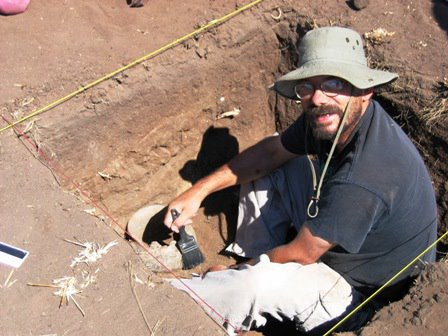(Here's the last segment in my essay on the Forest Service and evolutionary theory. I rushed it a bit to get it on the blog, but the bottom line is that all resources management depends on Darwin evolution. There is nothing that Intelligent Design offers to maintain species, restore forest health, etc. Again, bear in mind that it was originally written for the public at large, although I'm pulling together a more in-depth article on the topic for peer-reviewed publication.)
Was Darwin Right? And Should the Forest Service Care?
Part III: Conclusion
IDT has no practical application to the management of natural resources that supercede or replace Darwinian natural selection. We now realize that species change can occur very rapidly, and each year there are more and more studies documenting measurable physical differences between populations in no more than a few decades. This is documented for a host of species including salmon, cichlid fishes, squirrels, rats, guppies, mosquitofish, finches, and a host of plant species. We depend on these evolutionary principles of species variability, inheritance and adaptation to develop management techniques to reach a desired ecosystem condition. There are, however, serious philosophical implications for natural resource management and conservation if IDT is legitimized as scientific inquiry through no other mechanism than public appeal.
The fact that IDT proponents have convinced the broader public that a non-scientific idea merits discussion alongside serious scientifically backed theories does not bode well for biological conservation and management science. Christopher Mooney, in The Republican War on Science, has documented a concerted effort by the current administration to either limit (in some cases outright censor) scientific research or promote scientifically vacuous ideas as legitimate science. While this occurs under all political philosophies, attacks on science have been particularly egregious over the last five years. Biologists, ecologists, foresters and others who maintain scientific approaches are increasingly forced to defend their conclusions against non-professional administrators with the ability to elevate baseless conjecture to the status of alternative theory in the public arena. Whether it is outright dismissal of solid data on sage grouse distributions without appropriate countering data or warping collection of blind test data on lynx to promote a public perception of unethical behavior on the part of agency biologists, the methods mirror those of IDT advocates. Other agencies are affected as well. The current re-write of the National Park Service management rules to eliminate any reference to evolutionary biology is a clear attempt to remove scientific approaches to management.
If there is an implication for natural resource management that stems from ID, it’s that conservation biology is irrelevant. It is, after all, not much of a logical leap to go from “we don’t need an explanation, the Intelligent Designer just did it that way” to “we don’t need to worry about causes for species extinction, it’s just all part of God’s plan”.
If it is true, as some ID theorists suggest, that the only way a cell could make a flagellum (or the only way some conifer species are more fire resistant than others) is if the characteristics were already coded for in their DNA. If this pre-structural coding is the result of intelligent design, then why bother limiting competition through selective harvesting? Moreover, is genetic information necessary for implementing management methods that take advantage of the genetic make-up of populations? Under evolutionary theory, the answer is decidedly “yes”; under IDT the practical applications of genetic information are absent. In response, IDT proponents may suggest that some combination of natural selection mechanisms and IDT principles is possible (another moving target!). But IDT does not apparently accept the evolutionary premises on which genetic variability, inheritance, adaptation and selection are based, therefore IDT has nothing useful to say about natural resource management. IDT proponents are not specific about the instances, locations and conditions under which Darwinian mechanisms might be overridden by Designer intervention. So if ID proponents accept some Darwinian mechanisms such as adaptation, then why not all? What separates some principles from others? With IDT there is no way for managers to predict the outcome of their management strategies and adapt to new conditions.
Of course the ultimate goal of IDT is not to develop testable hypotheses and build applicable knowledge to real world problems. If there is any goal of IDT advocates, it is to justify their personal belief in an omnipotent, intelligent designer. However, considering the prevalence of extinction throughout life’s history, the presence of genetic anomalies like mutation, and more importantly, the inherent ability of the human species to manipulate and change the environment seemingly at will, the broader implication of IDT is not an omnipotent designer, but rather a significantly impotent designer.
Land management agencies rely on Darwinian principles to maintain species, restore forest health, develop genetically appropriate species for reforestation, combat invasive species, promote sustainable ecosystems, and help protect the environment in which we live. Unfortunately, most agency scientists do not understand the nature of the creation-evolution debate or the impacts it has on their own fields of expertise. Biologists, ecologists and other environmental scientists within land management would do well to pay attention and get involved in debates over evolution and science. They can start by checking up on their local school districts to ensure their children are getting a proper science education. They can volunteer to present good science in the classrooms. They can publicly support teachers who are being pressured to offer non-science alternatives or find it easier to just stop teaching science. They can be more vocal in identifying the evolutionary principles underlying management to a broader audience. They can include more evolutionary theory in interpretation and public outreach. Our public lands are too important to be managed on anything but the best available science.
Sunday, August 20, 2006
Subscribe to:
Post Comments (Atom)




1 comment:
I can't believe how much of this I just wasn't aware of. Thank you for bringing more information to this topic for me. I'm truly grateful and really impressed.
Post a Comment